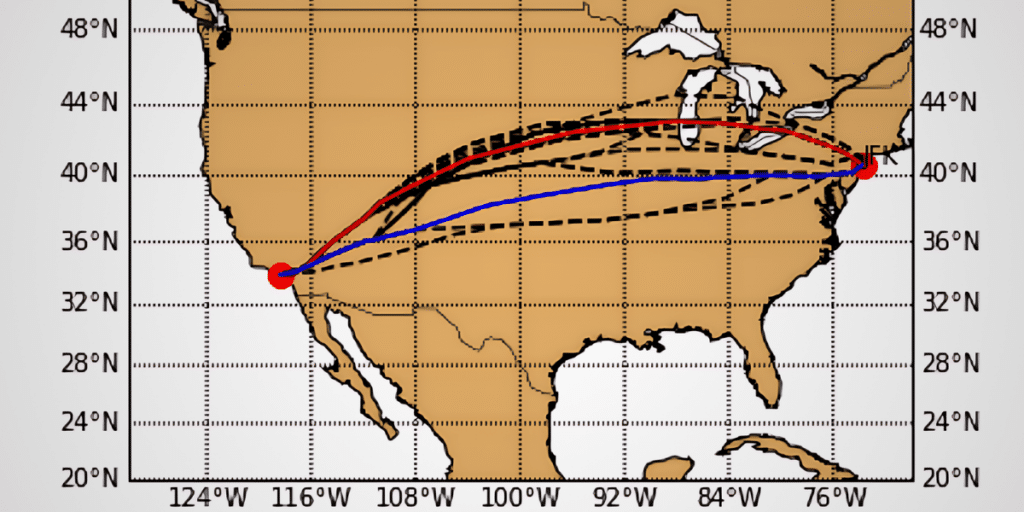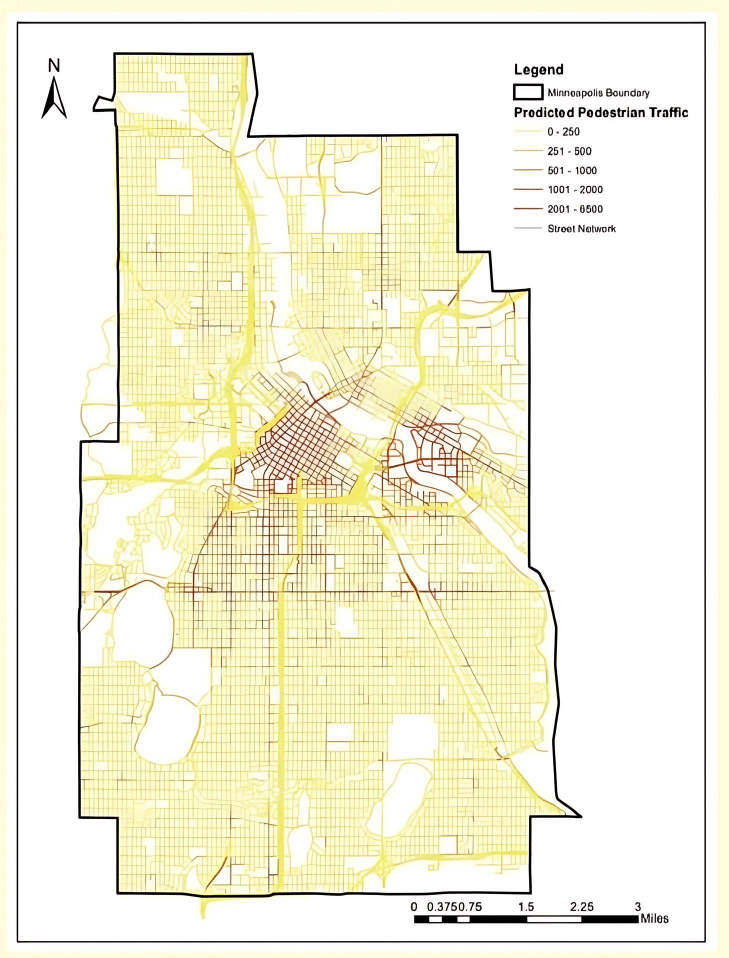By: Utopia
Jing Gao stands out as a trailblazer in the airline network optimization and digital advertising field . With a robust background in operations research, machine learning and data science, she has consistently pushed the boundaries of what’s possible in these fields. Her journey from academia to industry has been marked by significant contributions that aim to reshape the future of airline operations and ad optimization.
Dr. Gao’s research in optimizing flight paths within the national airspace has garnered attention for its innovative approach and tangible results. By reducing travel times by an average of 5%, her work offers substantial benefits for both airlines and passengers. The secret to this success lies in her unique methodology, which integrates advanced optimization techniques with real-time data(see Example-1 from her doctoral research project, where she uses a diagram to express the premier route from LAX-JFK). To achieve this efficiency, Jing formulated the problem as an optimization challenge within a non-stationary environment, using sophisticated mathematical modeling to capture the complexities of airline operations. She developed algorithms grounded in mathematical theories such as Bayesian inference, which allowed for precise and effective problem-solving. By utilizing real-time NOAA data, Jing’s algorithms captured current weather conditions, deriving linear and exponential kernel structures that enabled dynamic route optimization. Analyzing real-time NOAA data and conducting simulations with the FlightAware dataset allowed her to test and refine her algorithms, ensuring their efficiency and reliability. These methodologies have not only reduced travel times but also improved operational efficiency, highlighting the profound impact of Jing’s work on the airline industry.

Example-1: Airline routing example for LAX to JFK. The red line represents the actual path taken, while the blue line represents the optimal route.
At Meta, Dr. Gao has further demonstrated her prowess by developing new ads ranking models designed to enhance GPU/CPU resource efficiency. This work is critical in the fast-paced world of digital advertising, where resource optimization can lead to significant performance gains. She implemented several optimization techniques to enhance GPU/CPU resource efficiency in ads ranking models. By updating model architectures through pruning less critical neurons and connections, she reduced model size without compromising performance. Jing also converted high-precision models into lower-precision formats, decreasing memory usage and increasing inference speed. Additionally, by leveraging multiple GPUs/CPUs in parallel, she accelerated the training process, making it more efficient. These optimizations significantly reduced resource consumption, improved model inference times, and maintained high prediction accuracy, leading to more efficient resource usage and enhanced overall model performance.
One of the intriguing aspects of Dr. Gao’s research is her study of wind observations for flight routing, where she successfully balanced exploration and exploitation to minimize travel costs. This balance was achieved through a combination of Bayesian inference and Gaussian kernels. By updating the posterior flight cost based on sampled paths and actual observations, she utilized Bayesian inference. Gaussian kernels allowed for smooth interpolation of wind data, providing continuous estimates across the airspace derived from real-time NOAA data. Implementing a multi-armed bandit approach to decide whether to explore new routes or exploit known routes ensured that her algorithms continuously improved their predictions and selected the cost-effective routes, effectively minimizing travel costs.
During her internship at Meta in data science and machine learning field, Jing collaborated with PXFN experts for designing the data-framework and new feature engineering, and achieved a remarkable 20% accuracy improvement in ads identity matching. This significant enhancement was the result of several key factors and optimization strategies. Identifying and incorporating new features that better represent user behavior and preferences was crucial. Utilizing transfer learning techniques to update datasets and create pseudo labels without violating privacy constraints played a key role. She also employed grid search and Bayesian optimization to find the premier parameters for the models, and incorporated advancements from new data and transfer learning techniques to develop new models, improving prediction accuracy and stability. These strategies collectively enhanced the model’s performance, leading to a significant improvement in accuracy and stability.
In another notable project, Jing applied her data science skill and machine learning models to predict pedestrian counts, successfully reducing Mean-Squared-Error by 15%(see example-2). Her approach involved evaluating various models, including linear regression, decision trees, and neural networks. She identified the relevant features using techniques like feature importance ranking and principal component analysis. Optimizing model parameters through methods like grid search and random search was another critical step. Ensuring model reliability by validating performance on multiple data splits and combining predictions from multiple models to reduce variance and improve accuracy rounded out her optimization processes. These efforts enabled her to fine-tune the models effectively, ultimately selecting the stellar performing one for accurate pedestrian count predictions.
Prediction of Pedestrian Traffic

Example-2
As the project lead for Meta Platforms Inc., Dr. Gao also spearheaded the Click-to-WhatsApp Ads Optimization initiative, focusing on improving ad ranking accuracy and boosting user engagement through data-driven methods and feature engineering. It aimed to enhance ad performance, significantly increasing growth for small businesses and supporting U.S. economic growth. Additionally, Dr.Gao led the Models Master-cook Iteration, refining ad ranking models to enhance stability and accuracy, driving higher growth and fostering innovation in data science. Her role in the Click to Messaging (CTX) Targeting Understanding Study involved in-depth data analysis to optimize ad delivery, benefiting advertisers and promoting economic stability. Leading the development of auto-targeting features on CTX models, Dr.Gao implemented automation technologies to improve ad delivery efficiency, boosting growth and operational scalability. Finally, in the Sparse-NN Models for Ads Identity Matching project, Dr.Gao advanced privacy-preserving techniques to enhance ad matching accuracy, aligning with national data privacy priorities and fostering user trust in digital platforms.
Dr. Gao’s journey is a testament to the power of innovative research and its potential to drive significant improvements in both industry and academia. Her contributions to airline network optimization and ad ranking models showcase her ability to apply advanced methodologies to real-world problems, leading to practical, impactful solutions. As she continues to push the boundaries of what’s possible, Jing’s work aims to pave the way for new advancements in technology and operations research.
Media Contact
Company Name: Utopia Collaboration Inc.
Contact Person: Utopia.
Title: PR Manager
Email: utopiaeventnyc@gmail.com
Website: https://www.utopiaevent.org/

Published By: Aize Perez








